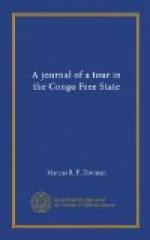Leaving Sonna Gongo, the line rapidly searches for a lower level and the view is magnificent, as a great endless expanse of land is unfolded. Here and there are banks of smoke caused by the veldt fires and often close to the railway the high dry grass has been lighted by a chance spark from an engine, and is burning furiously. We now zigzag down hill instead of up and far beneath, can be seen the thin line of rails glistening in the sun like fillets of silk. Having reached this level, we plunge through inviting looking forests at one time full of elephants, buffaloes and other game, but practically deserted now save by monkeys and parrots.
Soon after the train stops at a station where the natives have assembled to sell fruit and kwanga, a kind of bread made from the flour of the manioc root and the chief article of native diet. It consists chiefly of starch and is not unpleasant when fresh and toasted. The natives however, prefer all food in a high stage of decomposition and it is some time before the very smell of it ceases to make one feel ill. To see them eating kwanga fish or the flesh of elephants, monkeys, antelopes or other animals generally both rotten and raw is most disgusting and brings home the fact sharply that man here is of a very low type.
The oranges the natives sell are very acid, more resembling grape-fruit than the orange of Florida, but the bananas are as good as any in the world and the pine apples—three of which can be bought for half a franc—are equal to the finest hot-house variety.
[Illustration: THE STEAMER FLANDRE.]
The line now descends again until it reaches a flat hot, sandy and uninteresting plain across which it runs absolutely straight for seven miles until it reaches Kinshasa on the South bank of Stanley Pool. A few miles further on, is the rail head, Leopoldville. Like everything else in the Congo, this town has been arranged and built for practical use. The railway runs along the beach so as to facilitate the loading and unloading of the steamers of the upper river, and in a very short time all our baggage is taken from the train and carried straight on board the Flandre where we find cabins booked for us. This is an excellent arrangement and saves much trouble, for although the steamer does not sail for two days, passengers are allowed to live on board while in port. Indeed it is very necessary, for there are no hotels in the town, and no accommodation for visitors except a few rooms in the commercial houses.
Some traits of the native’s character were now to be demonstrated to us. His main idea always is, to do as little work as possible and he will often take the greatest trouble in his effort to accomplish this object. Each native endeavoured to put his load as near the gangway as possible which was soon blocked and then he had to come back, hoist the package on his head again and carry it to its proper place. Although this performance took place every day, unless




